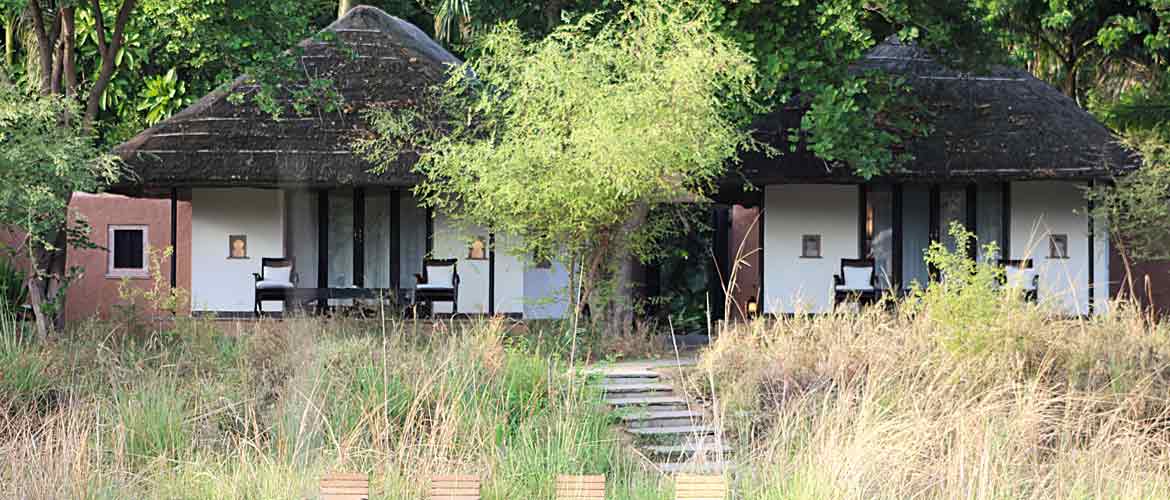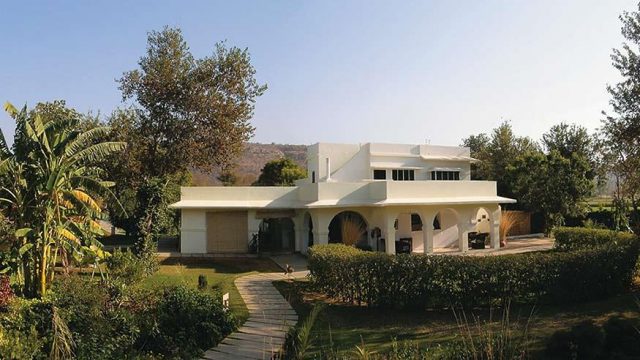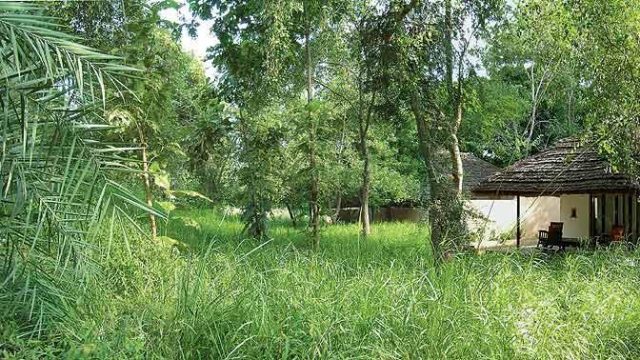When I was walking out of my luxurious thatched-roof cottage on my first day at

The land that Khem Villas is built on was purchased in 1989 and was completely barren. The team planted indigenous species of plants and trees and created water bodies so that the area could be reclaimed back from the desert and be converted into a natural habitat. The jungle camp, which was consequently built in 2006, is lovingly run by Usha and Goverdhan Singh Rathore, who have ensured, with meticulous effort, that the camp remains as close to nature as possible.
Goverdhan Singh Rathore is the son of late Fateh Singh Rathore, lovingly called Tiger Man due to his work in tiger conservation. He began his career as a game warden and famously assisted the then Duke of Edinburgh to shoot a tiger when he was visiting Ranthambore with Queen Elizabeth II in 1961. Ranthambore was a game reserve of the royal family of Jaipur then. Soon after, Fateh Singh took a keen interest in conservation. In 1973, when Project Tiger was started by Prime Minister Indira Gandhi, it was he who realised how much damage was being caused by the existence of villages within the boundaries of the park and how many tigers were being lost to poaching. He miraculourly managed to convince 16 villages to move out of the core area of the park. Nature reclaimed the land and the deer came back to graze, which gave the tigers of Ranthambore a new lease of life.


I arrived at Khem Villas after a gruelling 8-hour drive (Ranthambore is such a popular summer getaway, that I couldn’t get a train ticket). After a lip-smacking lunch consisting of surprisingly delicious cold spinach soup, sweet potato fries, pomegranate and cucumber salad and cheese toasties and a short snooze, the first thing on my agenda was a nature walk. And no, you don’t have to walk all the way to the national park. The property has been built in a way so as to seamlessly meld with the surroundings, so it’s extremely common for animals to just wander in. Khem Villas has two resident naturalists, Mittal and Digvijay, who can take you for nature walks within the property. “Some of our guests book safaris, but end up not going because you get to see so much in the property itself. This is especially true for birdwatchers,” Mittal explained to me during our nature walk.
At Khem Villas, you’ll get to see at least 175 bird species, out of the 272 species that reside in and migrate to Ranthambore National Park. Remember to carry a pair of binoculars with you because, with every step you take, the naturalists will point out at least one species of bird to you and tell you all about it. They can also give you information on all the animals and trees found in the park, depending on what you’re interested in. Remember to ask lots of questions (even if you think they’re silly) to make your nature walk worthwhile. It was there that I found out that what I always thought were your regular parrots were actually Alexandrian parakeets all this while. They managed to make a birder out of me!
During my nature walk, I was told that the team sets up camera traps around the property during the winter to capture the wildlife that walks through the resort’s grounds – crocodiles, deer, hyenas, porcupines and tigers.
After spotting what must have been at least 50 species of birds on our 1.5-hour-long walk, with aching feet, I headed back to my cottage for some well-deserved rest.
It was on that very night that I met the couple behind Khem Villas, Usha and Goverdhan Rathore, to learn more about the eco-tourism initiatives undertaken at their property. I learned that even though they have 25 acres of land, they have only built on less than one per cent of it. “We could have built multiple three-storey buildings and made full use of the land we have, but we simply didn’t want to. We have only 13 tents and 8 cottages, besides the main building. And everything has been built using locally-sourced materials,” Goverdhan said to me as we sat near the pond.








I noticed that the lights around the hotel were dimmed so as to not disturb the wildlife around. Such a stark contrast to the irresponsible tourism practised by so many hotels near other national parks around the country. I remembered my recent trip to Jim Corbett National Park where the poor animals (and I had spotted a herd of sambar deer just outside the hotel I was staying at) were subjected to a late night karaoke competition with atrocious singing! This, in contrast, was utter bliss – for the guests and for the wildlife.
The running theme of the property is ‘self-sustainable’. Even the food that I consumed during my stay had been grown in their own greenhouse. “We have much more variety when it comes to vegetables in the winter. Needless to say, we serve only vegetarian meals. The dairy we get also comes from the cows we rear ourselves,” Usha chimed in. Another facet of the property is that more than 95 per cent of the staff at Khem Villas is local and are trained in-house. An effort is made to eliminate unnecessary plastic use on the property. Organic waste is composted and excess waste such as plastic water bottles are either sold for recycling or sent to the municipal dump in Sawai Madhopur.


At the property, reusing and recycling water is one of their main responsible tourism initiatives. Every drop of water that is consumed here is naturally recycled using reed filters and then re-used. Even the water in their plunge pool, which is sans chlorine, is fed back into their pond. “This is perhaps the only property in Ranthambore that recharges the groundwater levels. We have six rain-fed watering holes within the property,” said Goverdhan. It’s no wonder then that Khem Villas is an absolute oasis, noticeably cooler than the area outside.
Besides Khem Villas, the Rathore family is also involved in many other social initiatives. Goverdhan founded the Prakritik Society in 1994, which has many successful programmes under its ambit. Four hundred children from villages and towns around Ranthambore attend Prakritik’s Fateh Public School, instilling in the students a hunger for knowledge and a brighter future, something that the people of these villages have never aspired towards. Although the literacy rate in Rajasthan is 66 per cent, the female literacy rate is only 52 per cent, and that is a trend that the school is trying to subvert. The Prakritik Society has also introduced improved cattle breeds in the villages surrounding the park. These breeds can be stall-fed, which is a boon for the park since the villagers are not forced to take their cattle into the park for grazing. The society has also introduced a biogas programme in the villages, which has won the Ashden Award for Sustainable Energy. Besides this, the NGO also has a state-of-the-art hospital where patients from poorer sections of the society can get treatment for a nominal amount.

Khem Villas is also closely associated with Tiger Watch, an NGO launched by Fateh Singh Rathore in the 1990s. This is essentially an anti-poaching project that works with former poachers to protect the tiger and its habitat. Instead of demonising poachers and simply arresting and jailing them, Tiger Watch rehabilitates the poachers because most of them are from hunter-gatherer tribes with no other means of livelihood. Tiger Watch has involved the women from poachers’ families in handicraft production and has set up a hostel for their children so that they can be fed and educated on the condition that the poachers give up poaching.
The funds from Khem Villas are pumped into these programmes, which massively improve the lives of the people residing around the park.
“The tiger is the spirit of Ranthambore and without the tiger, there is no Ranthambore,” Goverdhan said.

Every single brick of this beautiful property reflects the values of its founders. That sense of balance, preservation and utmost respect and desire to give back permeates through the air at Khem Villas and fills everyone with a sense of wonder and respect for Ranthambore and its citizens, both human and non-human.
Each cottage has a view of the dense thickets that surround Khem Villas, and mine was of a copse that attracted a number of birds and the occasional langur. I awoke to the sound of chirruping birds and the gentle rustle of leaves in the wind the two days I was there. And what a pleasant way to wake it was!
My second day in Ranthambore began with a jungle safari. Unfortunately, the tigers were too busy doing other things to saunter across our jeep’s path. But I was happy enough to look at the many sambar, spotted deer, dancing peacocks, black-tailed mongooses, egrets and other colourful bird species that our guide pointed out to us.

Back from the safari, I had nothing planned. It was my day to simply relax and take in the surroundings of Khem Villas, take a few dazzling pictures of birds and critters and just enjoy the view. If you do have a few hours to yourself when you’re here, visit the Age Veda Spa and pamper yourself with some body or detox therapies like the Abhyanga, herbal bath or a Swedish massage.
Khem Villas also runs a river safari on the Chambal River on an imported Bayliner eight-seater boat. On this river safari, you might get to spot the critically endangered Gharials, one of the largest crocodiles found around Ranthambore. You’ll also get to enjoy a nature walk in the area. This safari will set you back by ₹9,000. The cost is inclusive of the taxi ride to the Chambal River and back.
You could also visit the nearby Dastkari Haat and buy a few souvenirs that have been hand-crafted by the women living near the park. When you go there, you will see them at work, meticulously stitching and sowing away. Everything from kurtas, skirts, dupattas and jackets to key chains, toys, blankets and figurines is for sale here.


As the sun went down, I sat near the pond taking in the sheer beauty of the place. You’re in the middle of Rajasthan, but you’re surrounded by so many shades of green. The breeze was strong, and an otherwise majestic egret was flying desperately against it – quite a hilarious sight.
I met naturalist Digvijay again that evening, and he had brought his spotting scope with him. Seeing that wonderful contraption at work really made me want to buy one of my own. He showed me a close-up of the egret’s beak and the other birds that could be seen around the pond. “So, did you see the baby crocodile in the pond yet?” he casually asked me. I was a few feet away from the baby crocodile this entire time and had no idea! He scanned the pond for signs of it, but we were unsuccessful in spotting the little critter. “Well, if you haven’t seen him yet, I have something better to show you. Come along.”
And so, I followed him to the back of the property where there are two adjacent watering holes. “There are crocodiles here?” I yelped. I was here just yesterday nonchalantly strolling up and down the pathway clicking away with my camera, feeling proud of myself for having captured lovely photographs of the bird life at the property. I remembered an instance where I had gotten quite close to the shrubbery around the pond to click a picture of a distant bird. I was that close to crocodiles? It’s no wonder that the hotel has a strict policy about wandering out alone at night.

Caution If you wish to take a walk around the property at night, tell the hotel staff and they will provide you with a guide. Do not take unnecessary risks by coming out of your room after dark. Animals tend to wander into Khem Villas (yes, even tigers). You can also come across venomous snakes and scorpions.
The sun was going down and Digvijay scanned the surface of one of the watering holes with his flashlight. At least 15 pairs of eyes glinted back at us. “Yes, they’re all crocodiles. As long as we make it back to the main area of the property before nightfall, we should be okay. They start travelling between watering holes at night. At least one crocodile here is 7-ft-long,” he casually informed me. A 7-ft-long crocodile? That’s a croc that’s almost two feet larger than I was, and no, I did not want to cross its path. Thankfully, we had two guards with us to prevent something like that from happening. Guests needn’t worry though; every night, this area of the hotel is cordoned off to prevent any untoward incident. He took his spotting scope and zoomed in on the eye of one the bigger crocs. What stared back at me through that spotting scope was menacing.
It was a clear night and he took the opportunity to point his spotting scope to the sky and showed me the moon. As bright as it looks in the night sky on the clearest of days, I have never seen so many craters as distinctively as I did that night. He also showed me the planet Jupiter and two of its moons. Being an avid stargazer, I was over the moon! If you happen to have an interest in stargazing, please inform the naturalists and they will be more than happy to help you pursue that interest. I woke up early to see Venus and Saturn, and just like that my stay at Khem Villas was over.
While it’s true that you could get a hotel that’s more luxurious and offers more creature comforts and facilities, the reason I recommend Khem Villas is because it affords a rare opportunity for something that we all inherently seek: the chance to be part of something greater than ourselves.
HIGHLIGHTS
- Property blends with surroundings
- Planting of indigenous trees and creation of artificial ponds
- Only vegetarian meals provided; vegetables grown in their own greenhouse
- Water is re-used and recycled, organic waste is coverted to compost
- Founded Prakritik Society, an NGO involved in education and healthcare
- Closely associated with Tiger Watch, an NGO that helps prevent tiger poaching
- Use of locally-made upholstery
- Employs locals; trained in-house
FAST FACTS
When to go The Ranthambore National Park is closed during the monsoon, and open from October to June. November to February is the best time to visit. March, April and May are oppressively hot, though they allow for some fantastic animal sightings through the bare vegetation
Khem Villas
VPO Sherpur Khiljipur
Dist Sawai Madhopur – 322001
Rajasthan
Tel: 07462-252347-48
Cell: 09414030262
Email: [email protected]
W khemvillas.com
Tariff Room: ₹15,500; Cottage: ₹27,500; Tent: ₹25,000 (inclusive of meals and taxes)
Activities
- Jungle safari
- Nature walk
- Birdwatching
- River cruise
- Stargazing
- Spa
- Shopping at Dastkari Haat
GETTING THERE
Air Nearest airport: Jaipur (200km/ 3hrs). Taxi ₹12–20 per km
Rail Sawai Madhopur Railway Station (13km/ 20mins) is served by the convenient August Kranti Express. There is complimentary pick-up for guests
Road Follow the Ranthambore Road to village Sherpur; Khem Vilas is 2km from entrance of the national park
Read more in the new Outlook Traveller Getaways Responsible Escapes
Ranthambore National Park
Rajasthan
India




